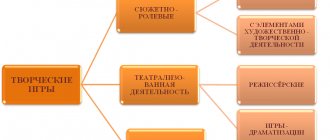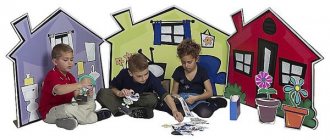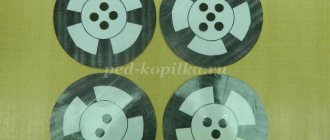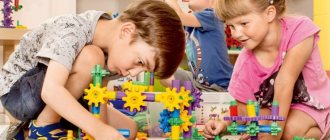THE ROLE OF SUBSTITUTE OBJECTS IN THE GAME ACTIVITY OF YOUNGER PRESCHOOL CHILDREN
So, E.E. Kravtsova states that “game is a certain attitude of the world to the child and the child to the world, the child to the adult and the adult to the child, the child to the peer and the peer to him” [5, p. 68]. Gaming activity, in contrast to play, is “a narrower concept; it presupposes special actions of children to model the world” [10, p. 201]. According to D.B. Elkonin, gaming activity includes “stages of its development: need, motive, goal, structure, “stating moments.” The latter, in turn, include an imaginary situation, a game role and the rules of the game” [10, p. 225]. As a rule, the concept of “game activity” is interpreted as a type of activity in situations aimed at recreating and assimilating social experience, in which self-government of behavior is formed and improved [6, p. 5].
Game activity is closely related to objective activity. In the monograph “Psychology of Game” D.B. Elkonin cites data from an experimental psychological and pedagogical study by F.I. Fradkina, confirming the fact that “all the main prerequisites for play arise during the development of the child’s objective activity under the guidance of adults and in joint activities with them” [10, p. 197].
As a result of mastering object actions, a child, under the guidance of an adult, learns the general scheme of action with an object related to its social purpose. According to the results of research by N.Ya. Mikhailenko, F.I. Fradkina, L.S. Slavina, “the path of game development goes from a specific objective action to a generalized game action and from it to a role-playing game action: eating with a spoon; feed with a spoon; feed a doll with a spoon; feeding a doll with a spoon, like a mother, is a schematic way to role-play” [10, p. 218].
Game activity is impossible without a game plan, role-playing actions, and game props. The most important condition for the success of gaming activity is the child’s emotional involvement in the game, awareness of its subjective emotional and entertainment significance. In the article “The Role of Play in Preschool Age” S.O. Kozhakina characterizes the types of story games:
- a game associated with a conditional (game) action in an imaginary situation;
- role-playing game itself (when the child directly takes on a play role around which an imaginary situation is built);
- director's play (when the child is the director, and the toys are actors) [4, p. 24-25].
A mandatory attribute of any game action is a toy. Play equipment allows the child to model an imaginary reality, based on the experience of objective activities and the experience of social interaction with others. The quantity and quality of gaming equipment determine the nature of the game (individual or collective), the form of the game, and the number of participants involved. A toy with a strictly fixed functional purpose establishes a certain set of role-playing actions with the object. The use of such a toy, as a rule, is limited to individual use and deprives potential participants in the game of the opportunity to “attribute” various properties to the game item, determined by the plot content of the game. According to teachers and psychologists, in particular O.A. Stepanova, M.E. Weiner, N.Ya. It is important to note that children’s games should contain “multifunctional play material, i.e. objects that do not have a strict functional purpose (sticks, cubes, etc.), since the finished toy largely inhibits the manifestation of children’s imagination” [9, p. 22].
For children from one to three years old
Crafts that develop fine motor skills will play an important role in thinking, the ability to analyze and reason. When it comes to babies who have only recently begun to walk independently, it is important to consider that their perseverance is minimal.
And the ability to correctly hold and manipulate a pencil or scissors in your hands or sculpt figures from plasticine is so rare in everyday life that it is equated to something especially admirable. That is why kids make crafts under the close supervision of an adult.
The goal of an adult when doing joint needlework is to guide, give an idea and provide the necessary tools and materials. During the work, an adult must not only show what and how to do, but also discuss all the actions performed. At the same time, clearly stating all the names and names of the processes.
You can forget about thorough correctness, evenness and beauty when working with one-year-olds. The main thing is that this form of communication brings positive emotions to both, and there is a desire to continue.
On the Internet you can find many photos of educational crafts, the sight of which will inspire you to create them. In this case, a wide variety of materials are used, ranging from leaves, twigs, paper and to specialized paraphernalia.
Examples
Below are several options for educational crafts for children of different ages. They can be performed both at home and in a kindergarten group.
Cave
You will need:
- thick cardboard from a box;
- large sheet of paper;
- glue gun
Step-by-step instruction:
- Cut out three elements from cardboard: a free-form base and two curved arcs of different sizes.
- Place the arcs perpendicular to the base and secure with hot glue.
- Crumple the paper and cover the resulting structure with it, leaving an entrance on one side.
- The voluminous, spectacular craft is ready. You can place animal figures inside, placing them on a pile of straw or on pebbles.
Tips for successful work
Before you begin your chosen work, you should listen to the following tips:
- Prepare all required materials in advance.
- Scissors for children should first of all be safe, so they are suitable only with rounded ends.
- Consider protecting your work surface. It is better to cover it with oilcloth, and put special plastic boards for modeling.
- When painting with paints, you should make sure that the water is not very cloudy. After completing the drawing, it is good to cover the paints to prevent them from drying out, and wash your hands well.
- When sculpting, if there is no goal to dry the material, you need to wrap it in a suitable material: clay - in a piece of damp cloth, plasticine - in plain paper.
- Markers should be stored with their caps tightly closed.
- It is good to sharpen pencils with a sharpener.
For children from three years old
Most children start kindergarten at three years old. At this age, they are already more independent, since they can do a lot themselves: draw specific objects, cut out elements with straight sides.
Fine motor skills are already quite well developed. In this regard, they are able to cope with more complex crafts. Difficulties may arise in the first stages, but each time it will turn out better. Movements will become more harmonious and confident.
Educational crafts for kindergarten can be made from various materials: paper and cardboard, plasticine, glitter and small beads, feathers, pine cones and acorns. Working with small elements will help in the future with practical issues, such as tying shoelaces, fastening buttons on a blouse, and so on.
Shark made of clothespins and paper
Necessary materials:
- pin;
- colored paper;
- glue gun;
- toothpick;
- felt-tip pen.
Progress:
- Cut out two parts from blue paper: the upper part of the shark and the lower part. Draw an eye on the top.
- Cut out a small fish from orange paper. One that fits in a shark's mouth.
- Cut a small stick from a toothpick and glue an orange fish to its top. And glue the free part of the stick to the edge of the inside of the lower part of the shark.
- Take a clothespin and glue blue parts to its ends to make a shark. It turns out that when the clothespin is opened, the shark will begin to open its mouth, and the fish will try to escape. But when closed, it will again be eaten by predatory fish.
For children from 6 years old
For older children who skillfully handle scissors and other tools, we can offer educational crafts made from felt. This type of work is especially interesting.
At the same time, something special is created, not similar to other copies. This could be a Christmas tree toy, a puppet theater or a stand on the kitchen table. Such a creation can serve the creator for a long time or become a practical gift for a friend.In the process, skills in working with scissors are consolidated, interaction with a needle, thread and additional materials develops. It also trains fine motor skills at a higher level, improves artistic taste and improves patience and perseverance.
Mouse from a sleeve
Required tools and materials:
- sleeve;
- cardboard;
- colored paper;
- paints;
- glue;
- scissors.
Progress:
- Paint the bushing gray and let dry. This will be the body of the little mouse.
- Cut out ears and paws from gray cardboard.
- Make cuts in the sleeve to fix the cardboard elements in them.
- Cut an oval out of pink paper and glue it to the base. This will be the tummy.
- All that remains is to draw the eyes with eyelashes, a nose and two teeth.
Educational crafts for kids can be good helpers in studying many topics. For example, when studying shapes, you can make a chest of drawers from matchboxes and label each one with a certain meaning: circle, triangle, square. Then cut out these shapes from colored cardboard. This way the child will learn not only to cut out the simplest shapes, but also to sort them correctly.




